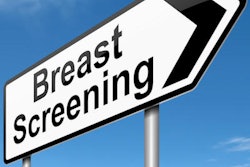
Women who live in areas with less gender equality are at higher risk of not being on schedule for screening mammograms or not having them at all, according to a Swiss study published February 28 in Social Medicine & Science.
Women who lived in areas of Switzerland with markers of gender inequality -- where women had lower levels of full employment and spent more time on unpaid work -- also saw lower levels of mammography adherence, according to research by Vladimir Jolidon from the University of Geneva.
On the other hand, Jolidon also found that women who lived with partners had higher uptake of mammography screening than women who did not. He also wrote that preventive policies, such as mammography programs, can help with the gender equality issue.
"Policymakers should devote attention to such upstream determinants of screening participation if they aim at promoting equal access to screening," Jolidon wrote. "Otherwise, policies and screening programs may suffer from inefficiencies and may not be able to reduce screening inequalities."
Macrolevel gender inequality means unequal distribution of power and resources between men and women. Recent research has pointed to its negative consequences on women's health and healthcare access.
In Switzerland, there is no nationwide mammography program since the country consists of 26 member states (called "cantons"), each of which autonomously manage their respective healthcare systems. Out of these, 12 cantons have implemented mammography programs that call for screening every two years at different time points between 1999 and 2017. For the other 14 cantons, screening is considered opportunistic, where women take their own initiative to be screened.
Jolidon wrote that the Swiss cantons show "varying levels" of macrolevel gender inequality. Indicators of gender inequality include gaps between men and women in the time they devote to unpaid work (gender gaps in time use) and levels of full-time employment.
Previous research suggests that screening and early detection can reduce social and geographic inequalities in breast cancer survival. Jolidon wrote that this means studying inequalities in mammography uptake is essential. The study aimed to do this by focusing on the implementation of regional mammography screening programs and women's cohabitation with a partner at the individual level.
Jolidon looked at data from 9,724 women ages 50 to 70 from the Swiss Health Interview Survey. Logistic models were used to estimate the association of mammography uptake with two canton-level indicators of gender inequality.
Jolidon found that women who lived in cantons with higher gender inequality were less likely to be up to date on mammography screening and were more likely to have never attended mammography screening, based on odds ratios. What's more, women who lived without partners were much less likely to be up to date on screening and much less likely to have never attended screening.
| Impact of partner cohabitation and gender inequality on mammography use | ||
| Odds ratio of being up to date on screening | Odds ratio of never attending mammography screening | |
| Women living in areas with gap in gender time use | 0.979 | 1.037 |
| Women living in areas with gender full-time employment gap | 0.984 | 1.028 |
| Women living without partners | 0.744 | 1.463 |
Jolidon also found that while women who live with a partner have a higher mammography uptake, this is moderated by canton-level gender inequality. This means that women who live with a partner in cantons with higher gender inequality have a lower mammography uptake than their counterparts who live in more gender-equal cantons.
Women who lived without a partner were at higher odds to not be screened when both gender time use gap and gender full-time employment gap were considered (1.495 and 1.516, respectively). For up-to-date screening, the odds ratio for gender time use gap was 0.743 and for gender full-time employment gap, 0.744.
Jolidon wrote that future research could look into how specific social and public health policies can change the effect of gender stratification on preventive healthcare access.
"The motivation and attitudes which underpin women's mammography uptake, including the role of doctors, particularly in more gender unequal contexts, also need to be further examined in order to design adequate public health interventions," he added.



















